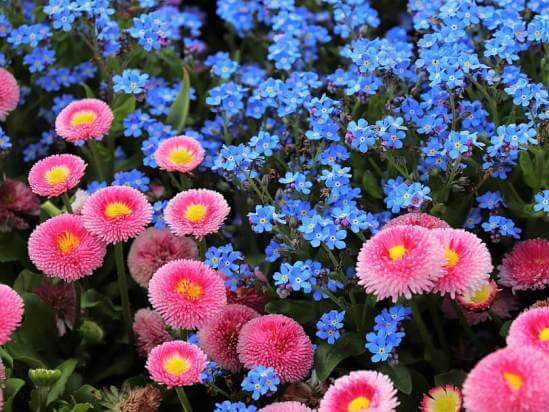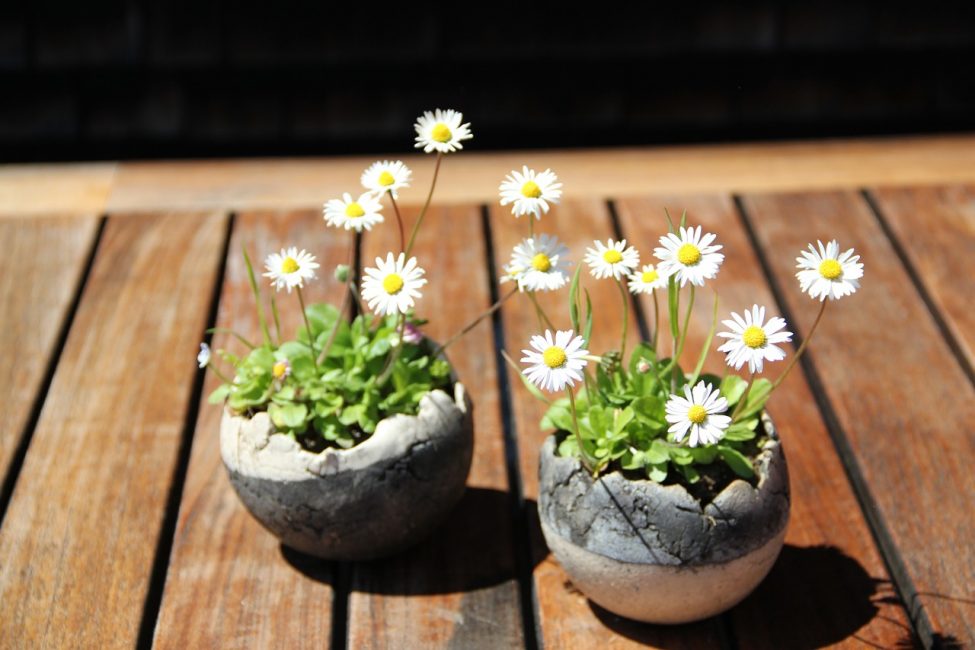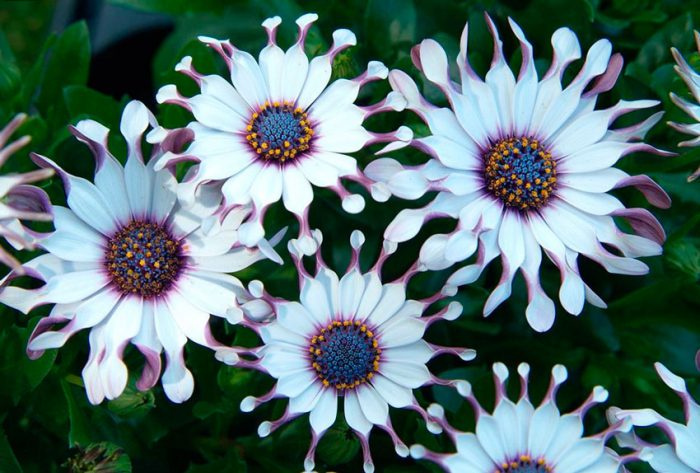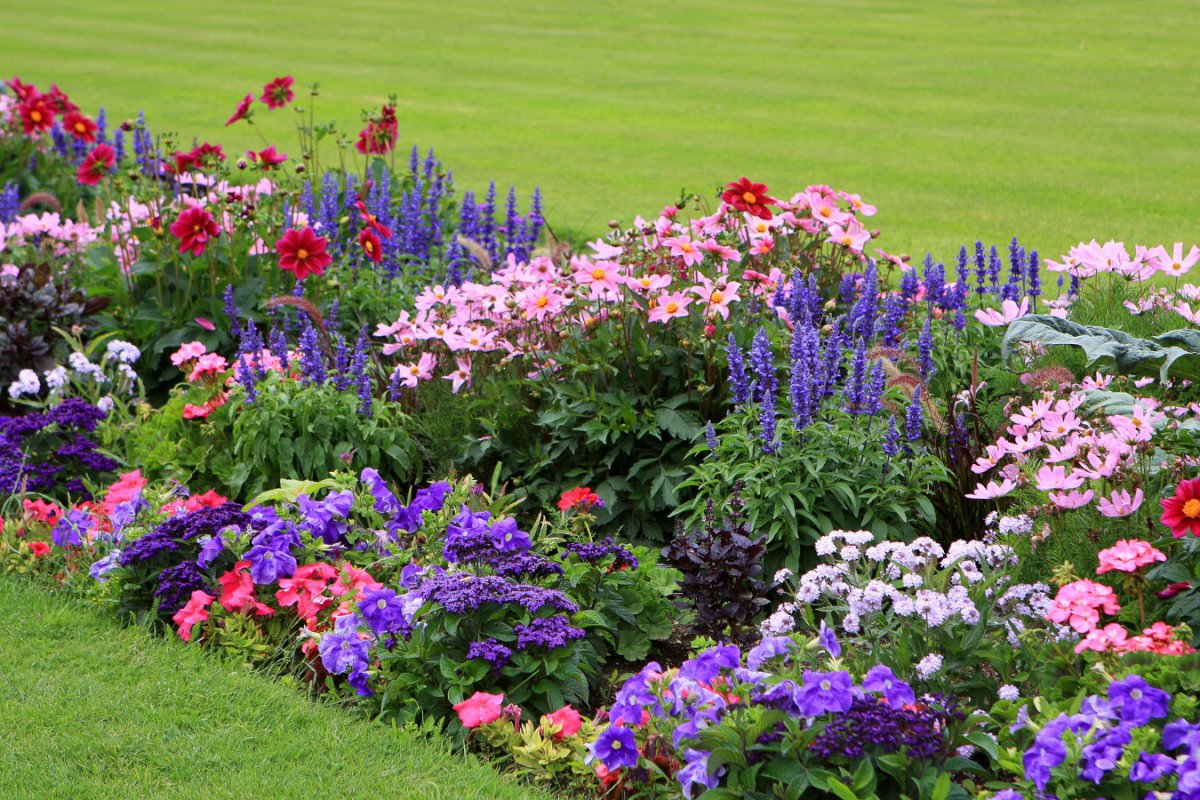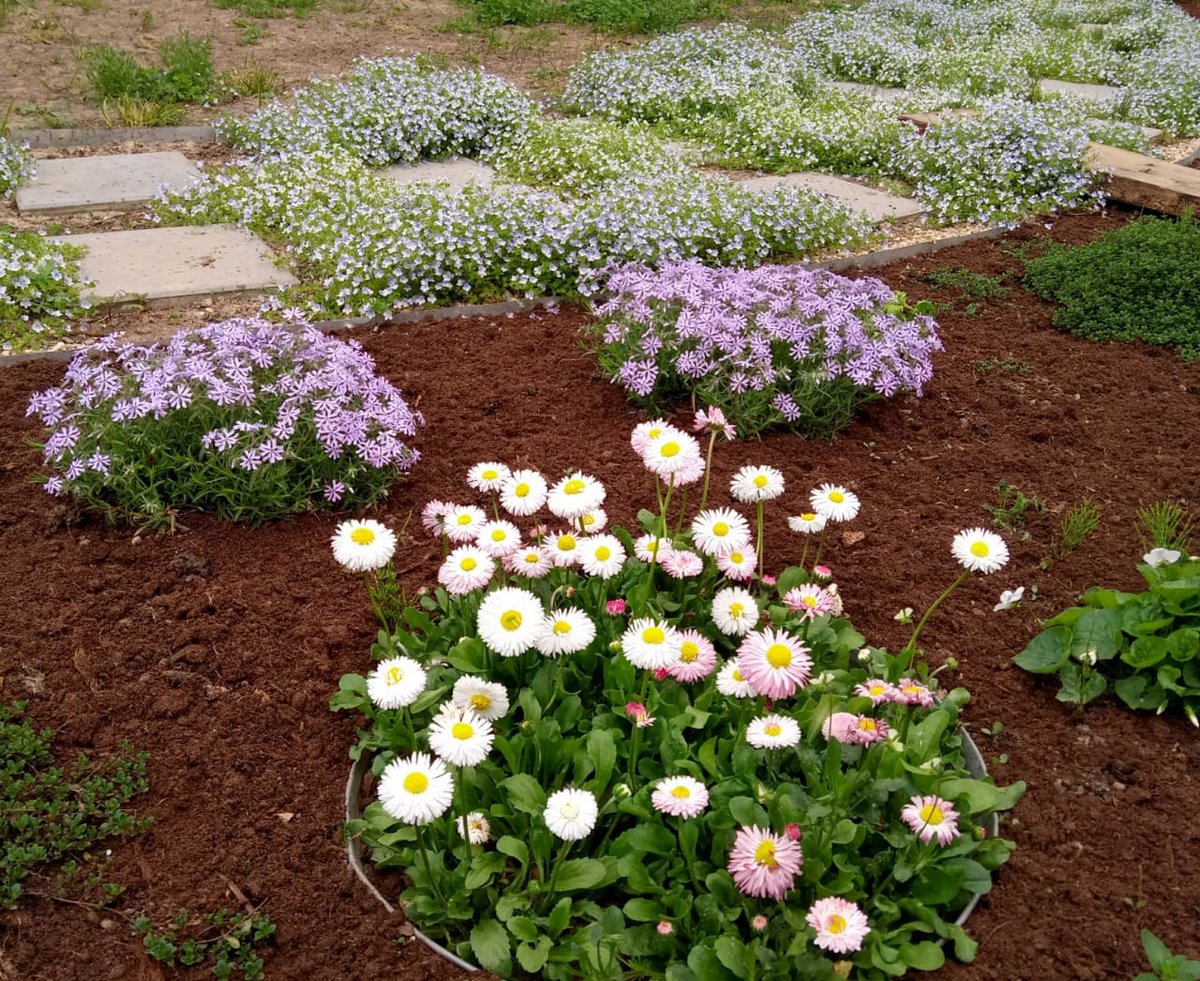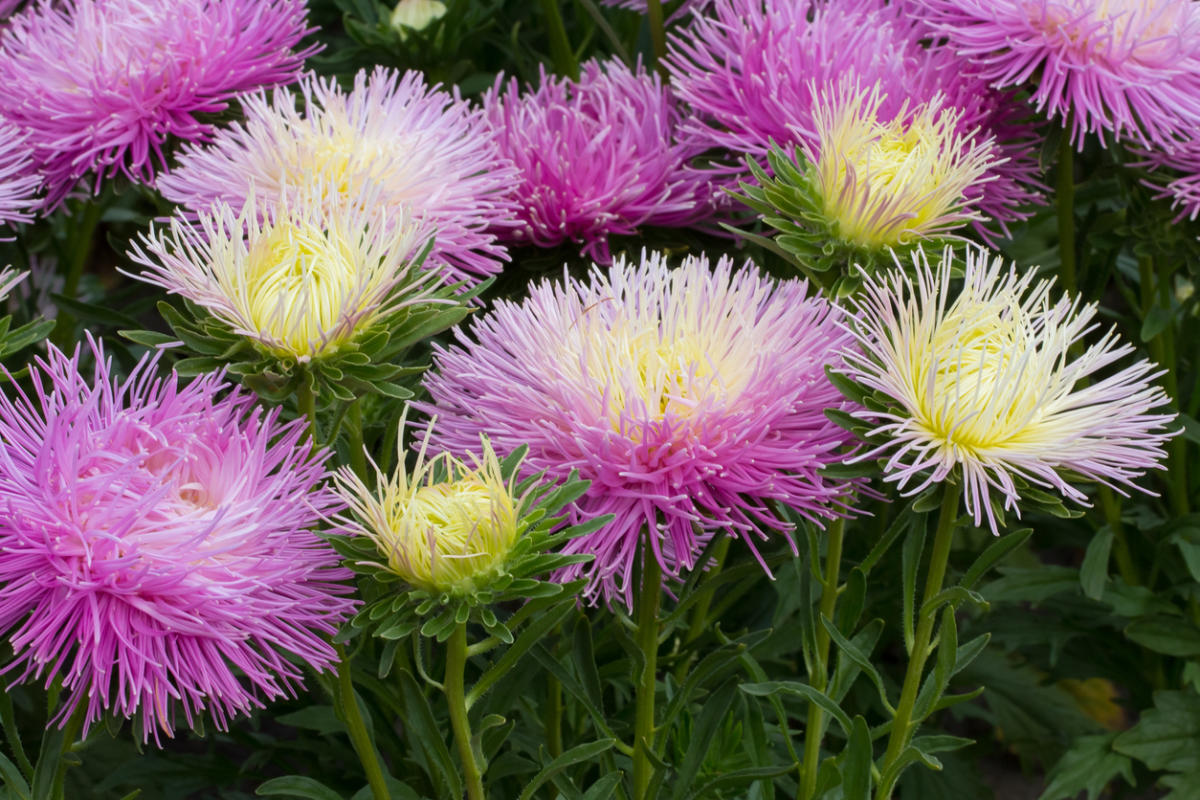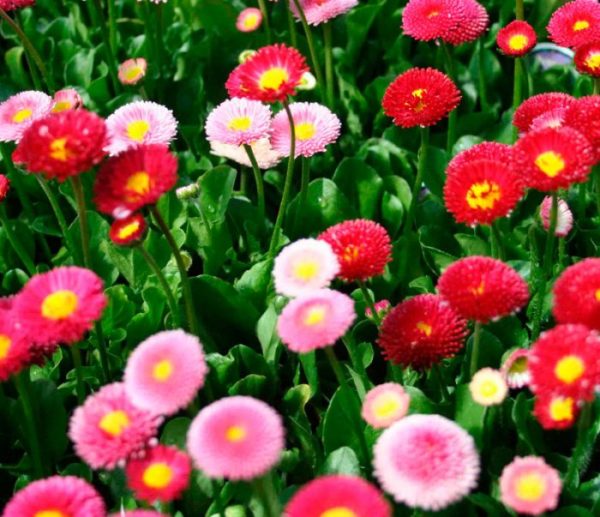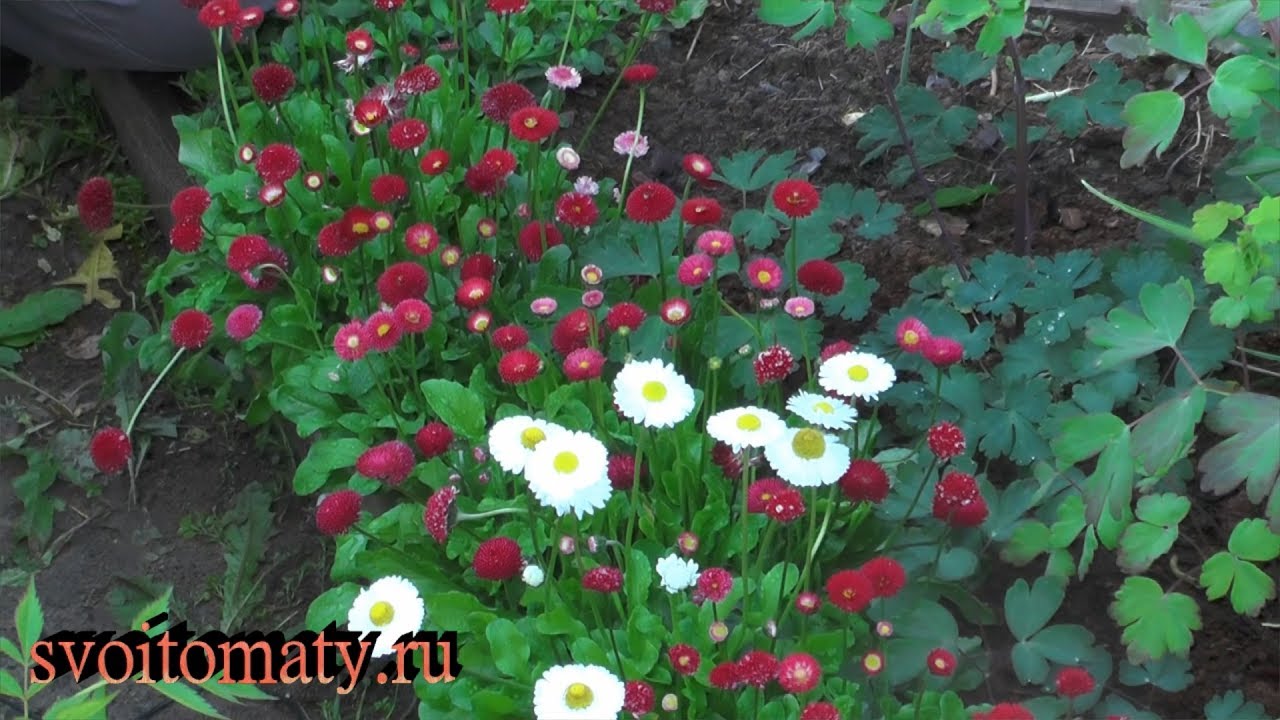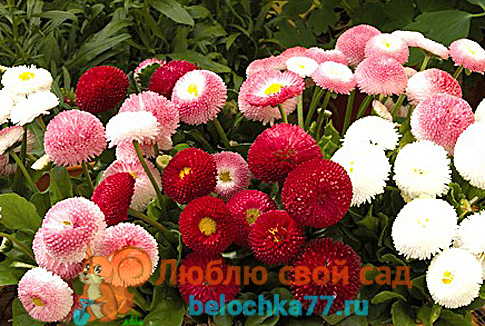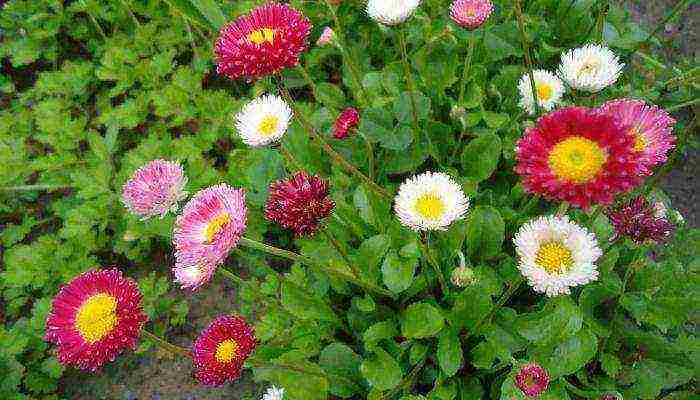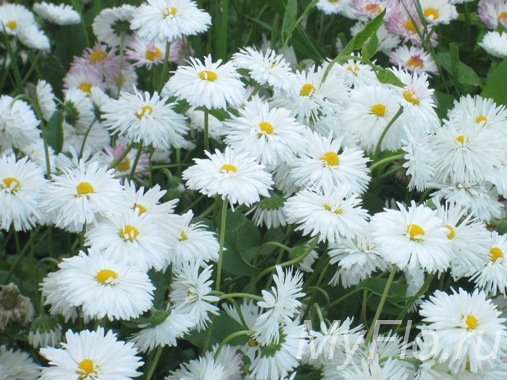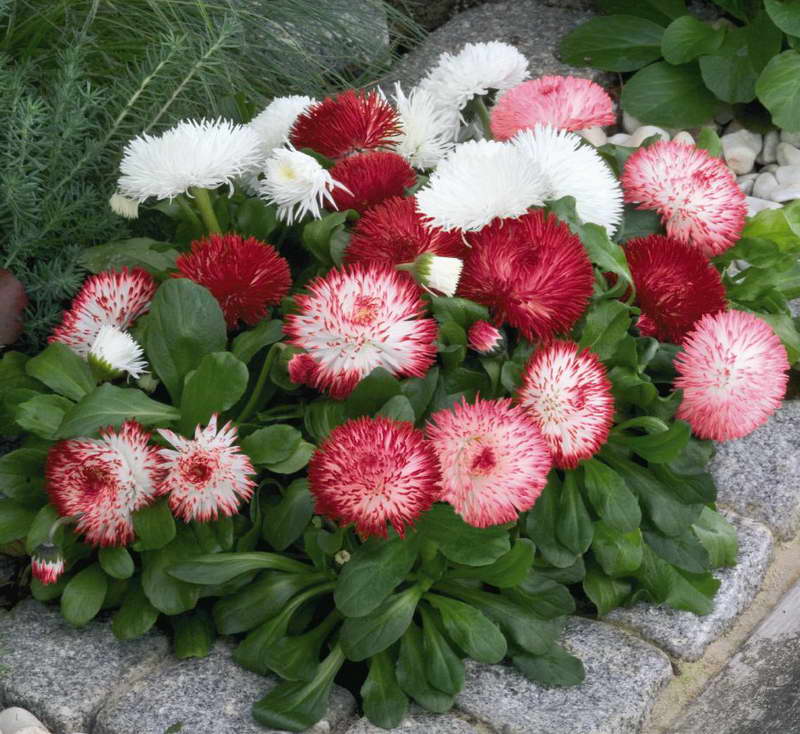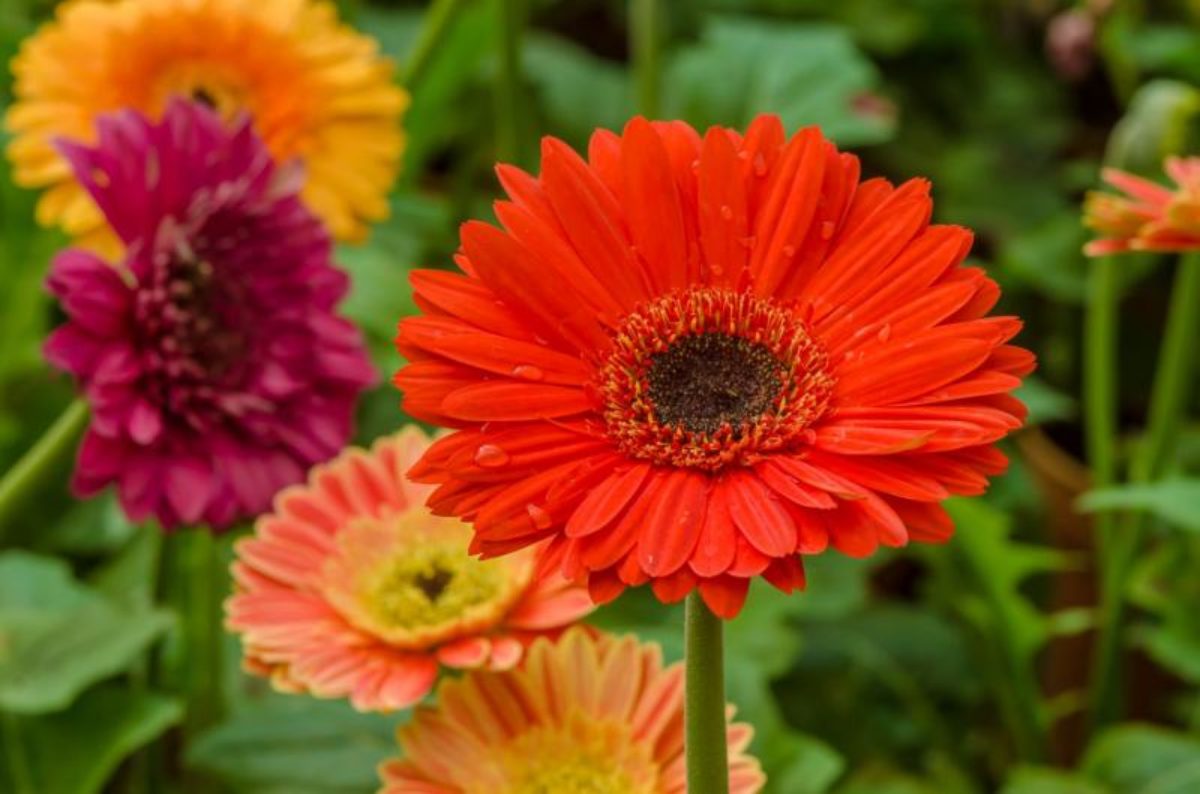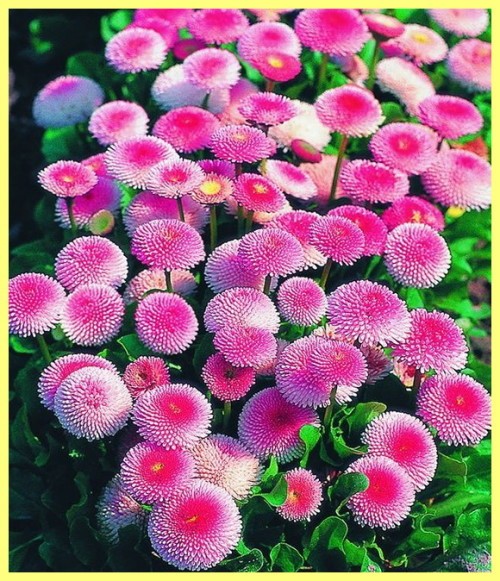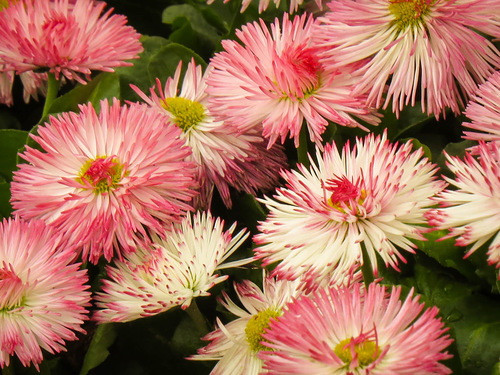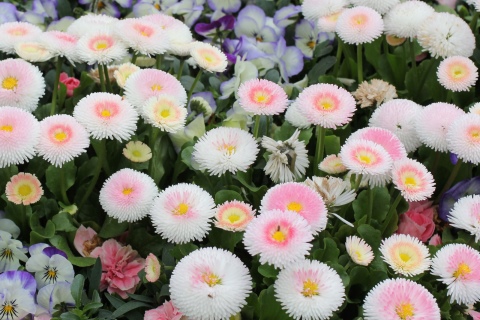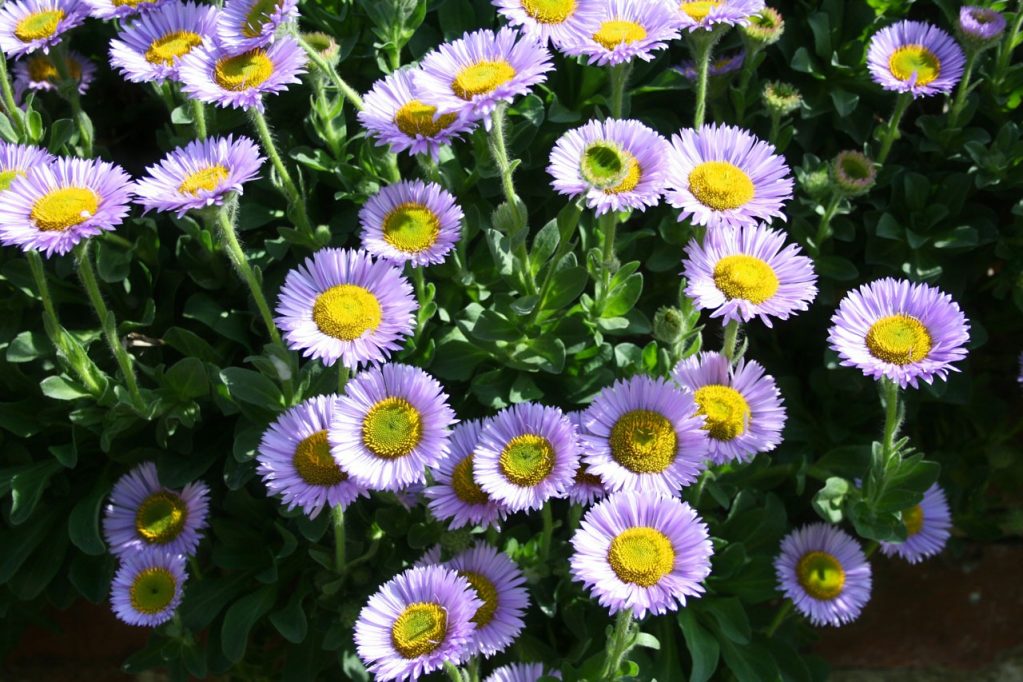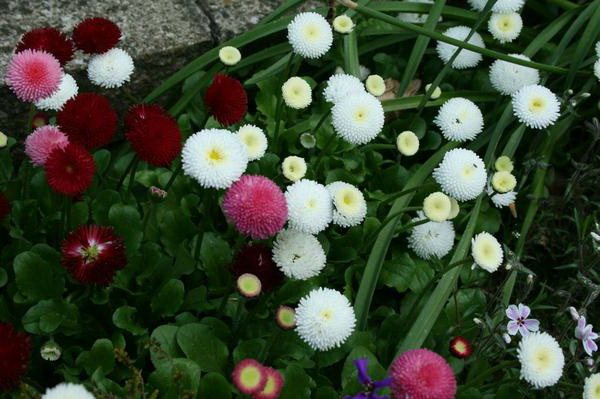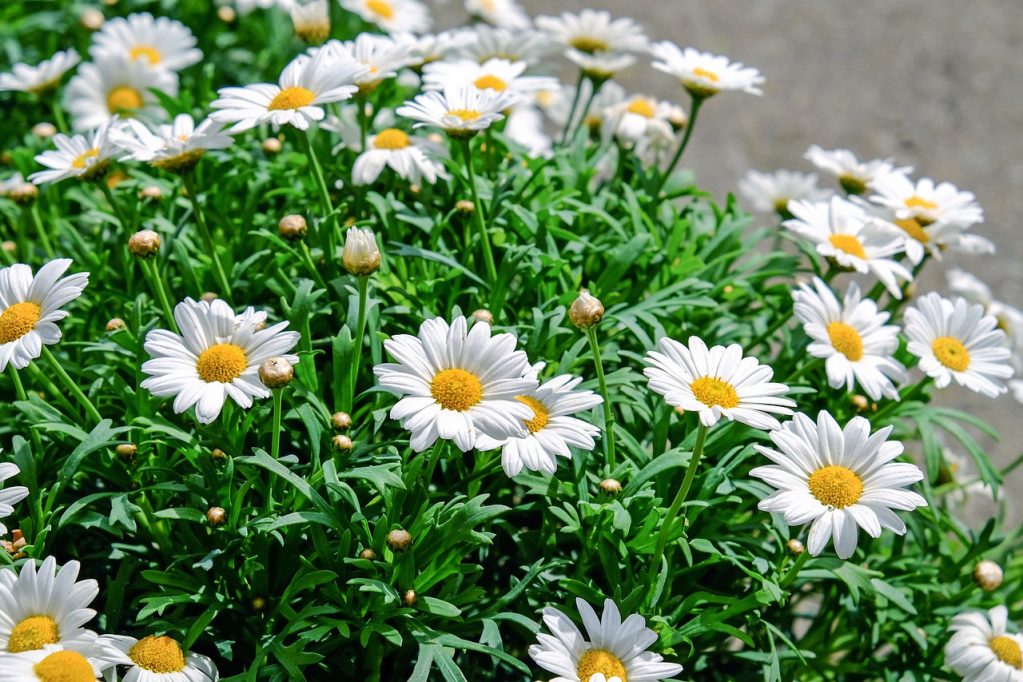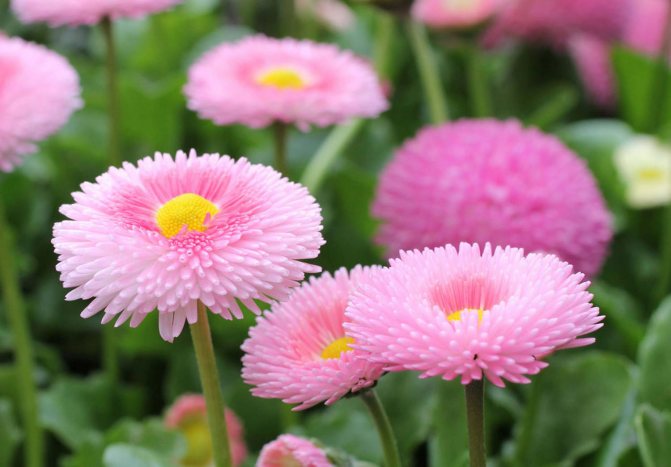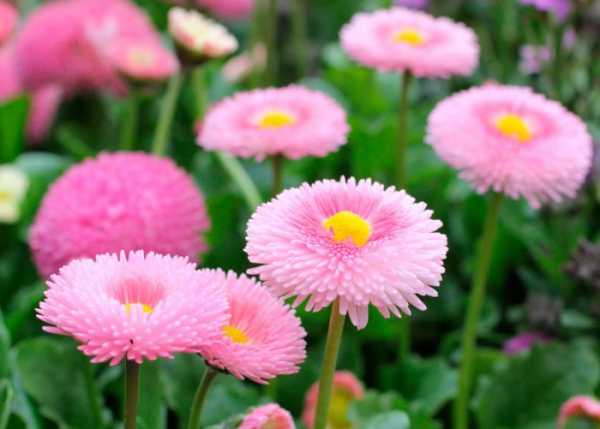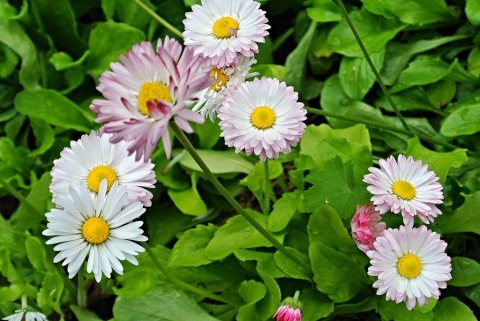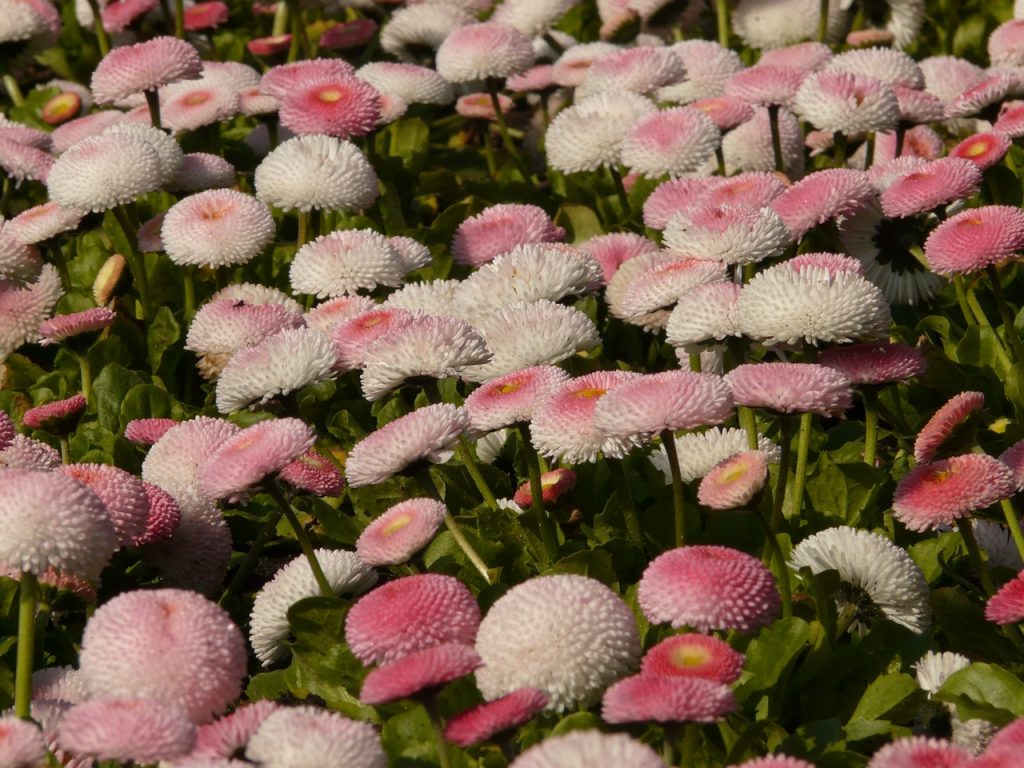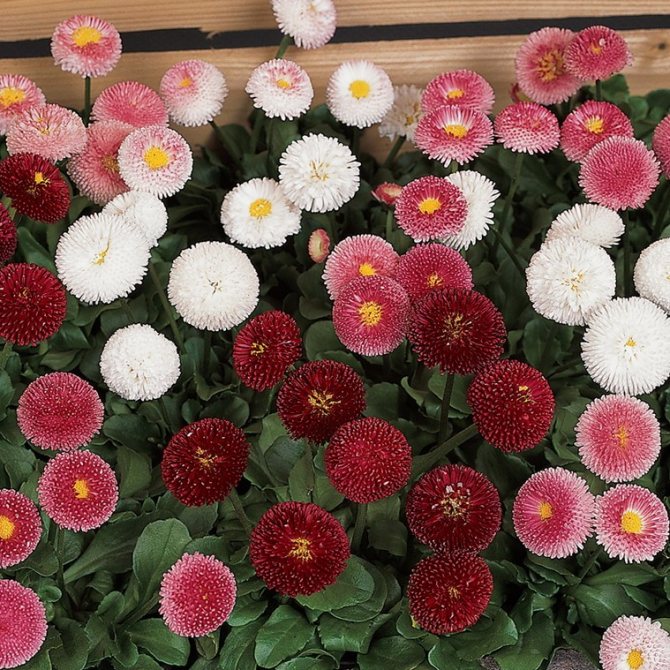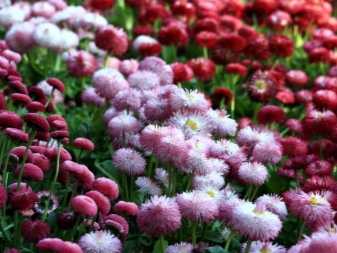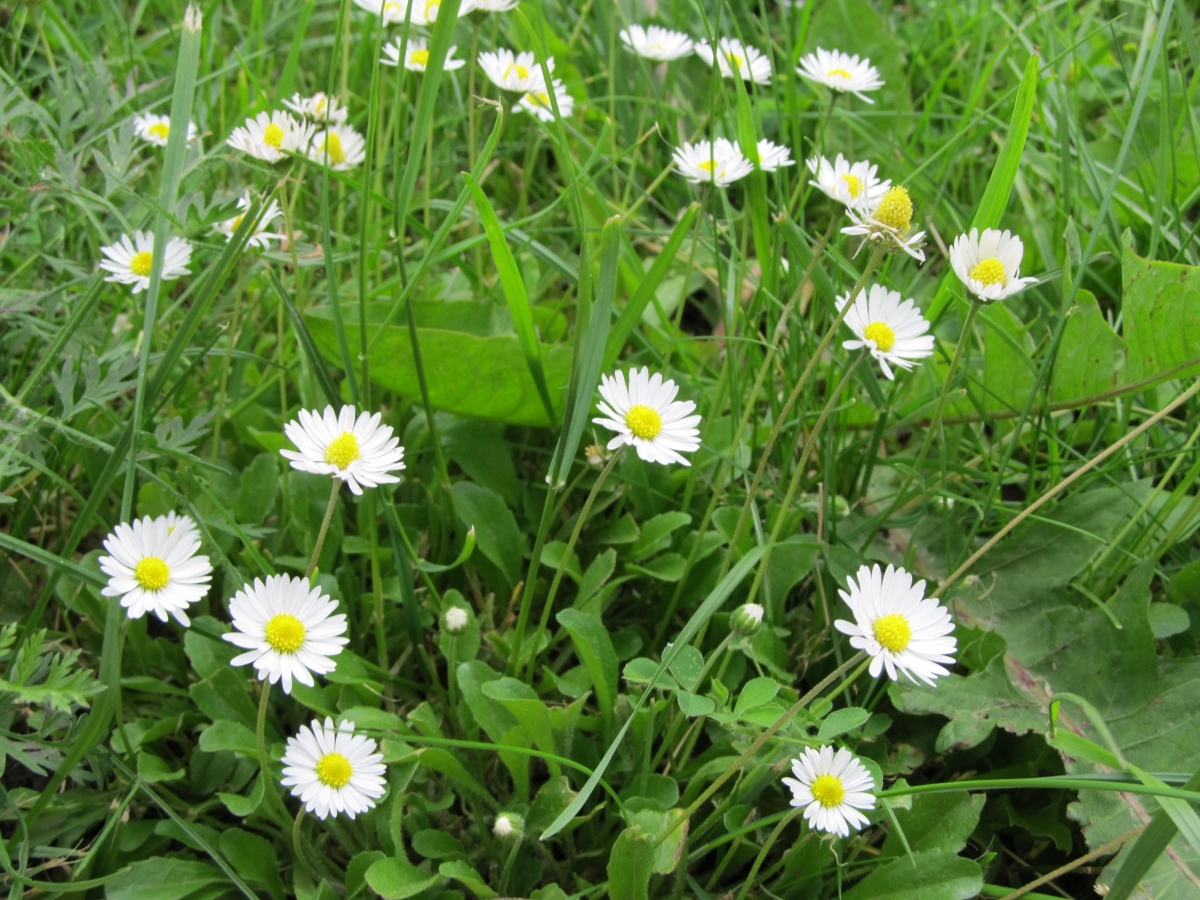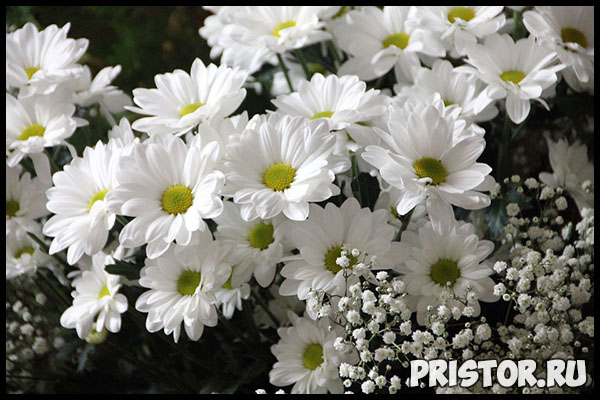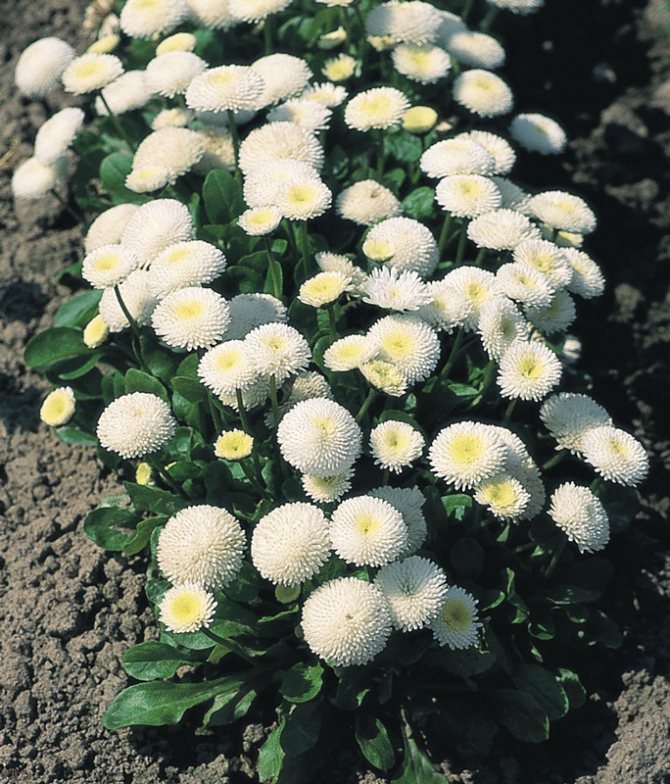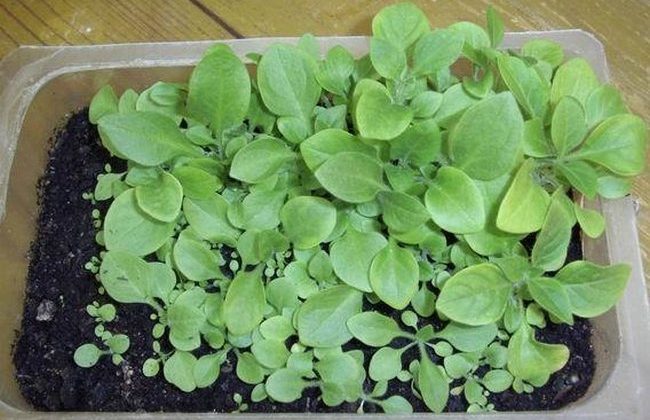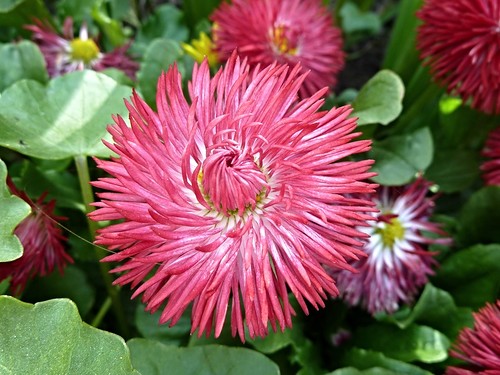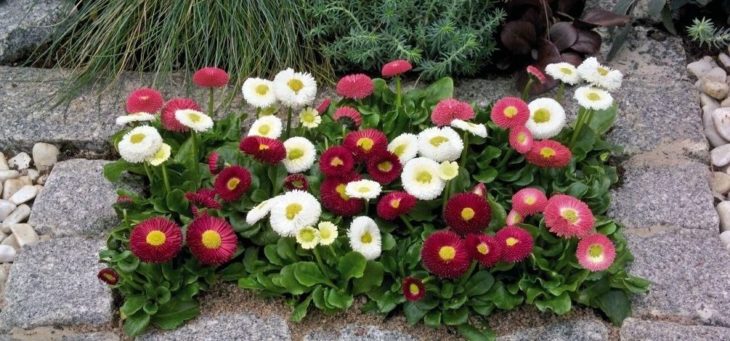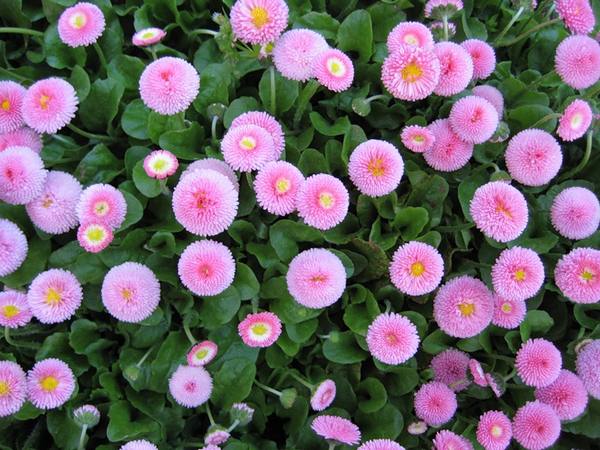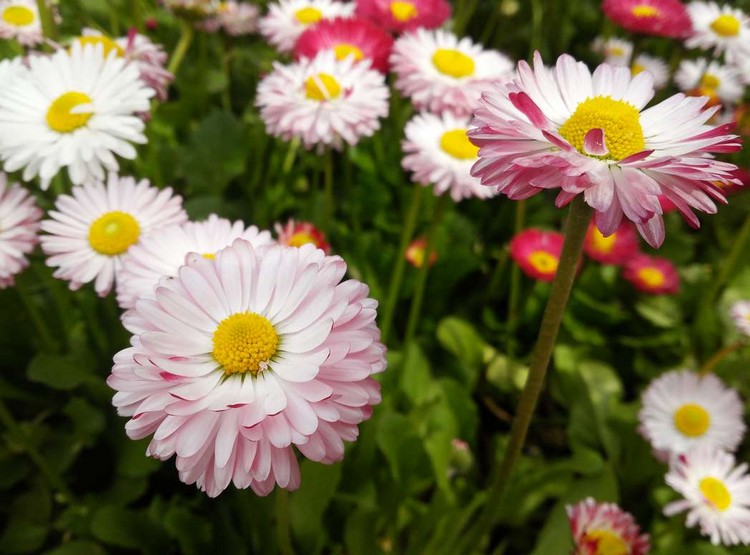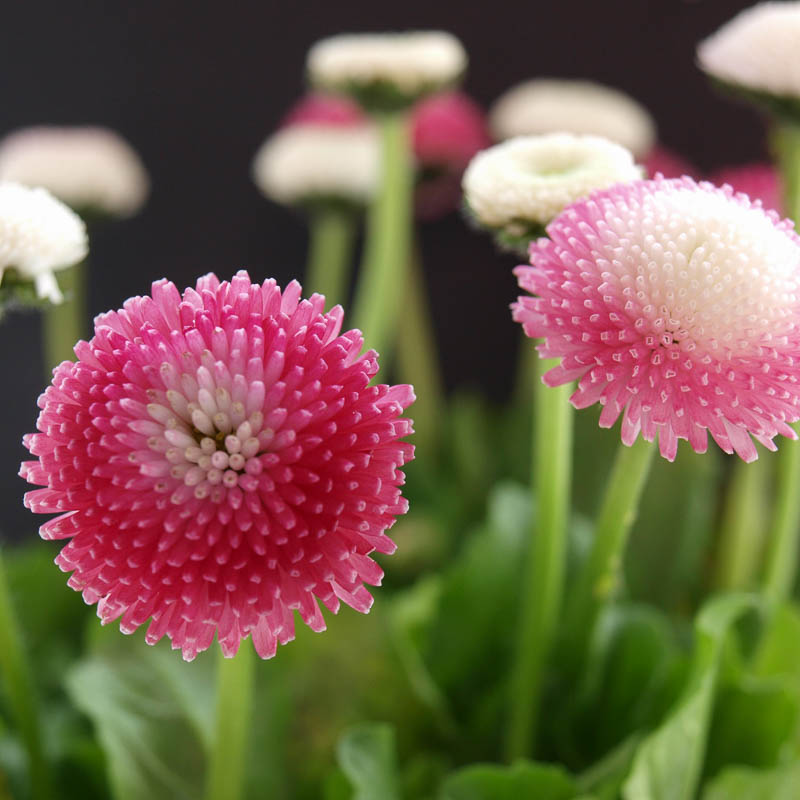Diseases and pests of daisies
Daisy is unpretentious and many diseases are not terrible for her. But it is susceptible to diseases such as: gray rot, rust, powdery mildew. The plant can also be damaged by rodents and insects.
1. Gray rot
The cause of the disease is damp cold weather.
The appearance of the bush is watery leaves with a gray bloom.
Disinfection - removal of the infected part of the plant.
Prevention - moisture reduction.
Preparations for processing - "Skor", "Pure color".
2. Rust
The cause of the disease is fungal infection.
The appearance of the bush is leaves with rusty-red or brown spots.
Disinfection - removal of the infected part of the plant.
Prevention - destruction of plant residues, loosening.
Preparations for processing - 1% solution of Bordeaux liquid.
3. Powdery mildew
The cause of the disease is soil oversaturation with nitrogen fertilizers, lack of moisture.
The appearance of the bush - the leaves darken, a white bloom appears above and below.
Disinfection - removing an infected part of a plant or destroying an entire bush.
Prevention - destruction of plant residues, thinning.
Preparations for processing - "Chistotsvet", "Fitosporin", "Trichodermin".
4. Brown spot
The cause of the disease is the defeat of the plant by bacteria.
The appearance of the bush - the leaves are covered with light spots with a border.
Disinfection - removing an infected part of a plant or destroying an entire bush.
Prevention - destruction of plant residues, loosening.
Preparations for processing plants - "Kuprotoks", "Hom"
Preparations for soil cultivation - ferrous sulfate solution, 3% Bordeaux liquid solution.
To protect flowers from animals - rodents: mice, shrews, moles - a poisoned bait is left on the site. Be careful not to poison her pets.
Insects that can harm the planting of daisies (spider mites and thrips) are destroyed by repeated spraying of the plant and soil. For spraying, use solutions of laundry soap, celandine, "Aktara", "Iskra".
Caring for daisies in the garden
How to care for daisies
Growing daisies does not require extra effort from you, it consists in watering, loosening the soil, weeding and feeding the plants. Since the root system of daisies is shallow, the plants must be regularly watered, otherwise their inflorescences become small from a lack of moisture, and terry varieties lose this quality.
After watering, you need to carefully loosen the soil around the plants to improve aeration of the roots.
If you mulch an area with daisies, you do not have to loosen the soil and fight weeds too often, and you will be able to water the daisies less often, since mulch prevents moisture in the soil from evaporating too quickly. In addition, mulch is a prophylaxis against such a phenomenon as root bulging, which occurs as a result of drying out of the top layer of the soil.
As for dressings, they must be applied at least twice a season. For 1 m², you will need 25-30 g of complex fertilizer for flowering plants with microelements. Be sure to also remove wilted daisies to prolong flowering and ensure quality.

Reproduction of daisies
In addition to the seed method of reproduction of daisies in garden floriculture, methods of vegetative propagation are also used - division of the bush and cuttings. Vegetative methods are needed primarily in order to preserve valuable varieties of daisies, the flowers of which begin to shrink with age and lose their decorative effect.
The bushes are usually divided in late summer or early autumn, although this can be done in spring. The bush is dug up and divided into 4-6 parts, after pinching all the formed flowers and buds, cutting off all the leaves from the petioles and shortening the roots to 5-8 cm in order to increase the ability of the cuttings to take root in a new place. Then the cuttings are planted in the ground, where they take root very quickly and continue flowering. If any division turns out to be without roots, there is nothing wrong with that: plant it in the ground, and new roots will grow from the base of the leaf cuttings of the daisy.
When grafting in the same time period with a sharp knife, side shoots with leaves are separated from the bush of daisies and planted on beds with loose soil, where they take root within two weeks. Daisies from cuttings will bloom next year.
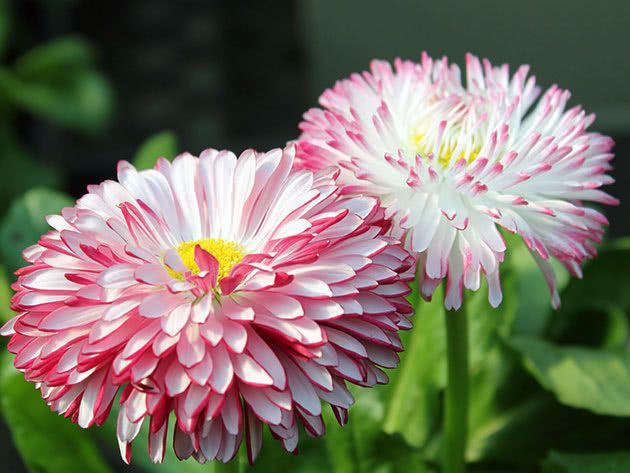
Pests and diseases of daisies
Small daisies are surprisingly rarely affected by both pests and diseases, but the danger of being affected by a viral disease still exists: sometimes at the beginning of summer, the plants begin to stretch out pedicels, the inflorescences become small, and the leaves shrink and turn pale. If you notice such changes, you must immediately burn the diseased specimens along with the root system, and disinfect the place where they grew with a strong solution of potassium permanganate.
There are cases of disease of daisies with powdery mildew, from which white or grayish loose bloom spreads over the leaves and flowers. You can destroy the fungus by treating all plants on the site with a solution of colloidal sulfur, Topaz or Bordeaux mixture, and it is better to remove and burn diseased specimens or their affected parts.
Sometimes daisies suffer from ticks that are killed by insecticide treatments such as Karbofos or Actellic. Daisies are also harmed by mice, which can be fought by spreading bait with poison on the site. Despite these troubles, which may not happen to your flowers with proper care, planting and caring for daisies can be considered more pleasure than work, especially since daisies will thank you for long and beautiful flowering for a little effort.
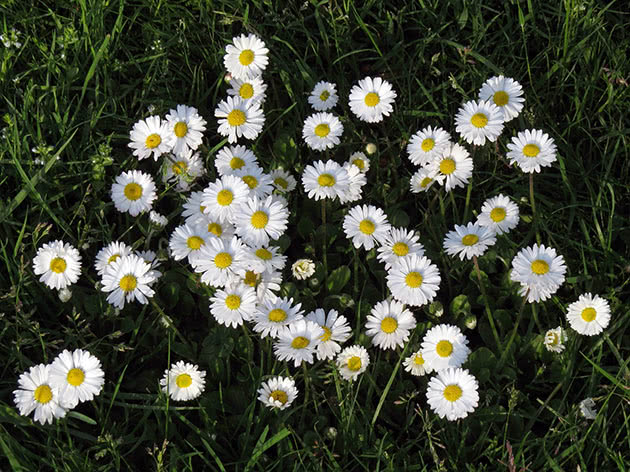
How to grow at home?
Some growers grow this representative of the flora in indoor conditions. To make him feel comfortable at home, place the flower in a pot in a well-lit place. To witness lush bloom, you can create a light partial shade or arrange diffused lighting. If you put the pot in a heavily shaded area, the culture will stop growing.
For keeping a flower at home Select a substrate that is permeable to moisture and retains moisture. For example, a mixture of loamy soil with humus is suitable. Give preference to wide and shallow containers - in these pots the plant will feel more comfortable.
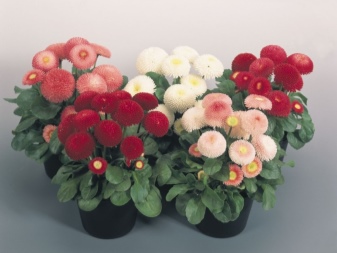
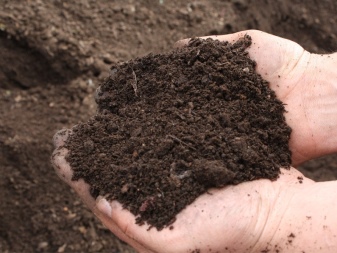
It is systematically required to feed the plant, usually additional nutrition is applied every 2-3 weeks. Florists recommend using complex mixtures or alternating mineral and organic compositions
Particular attention is required to be paid to fertilization at the beginning of spring - at this time the plant starts growing
Winter is not a problem for a flower that is grown on a windowsill. The growth of such a plant slows down, and in the spring, development resumes. After 2 years, the specimens become old, and for rejuvenation they need to be seated.
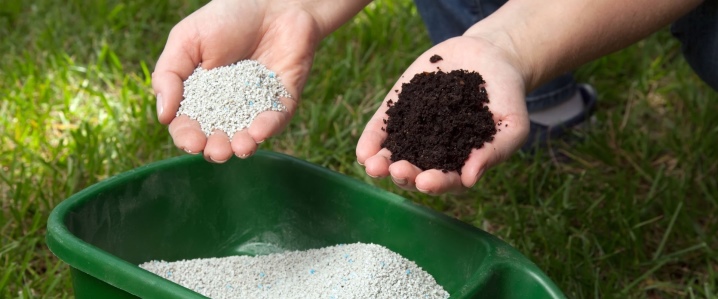
Botanical description of culture
It grows mainly in Mediterranean countries and western Europe. In garden design, it has several functions:
- frames flower beds;
- forms "carpet tracks";
- makes the border of the lawn more decorative.
There are about 15 known varieties of daisies. Gardeners cultivate both annuals growing in pots and perennials growing in gardens.
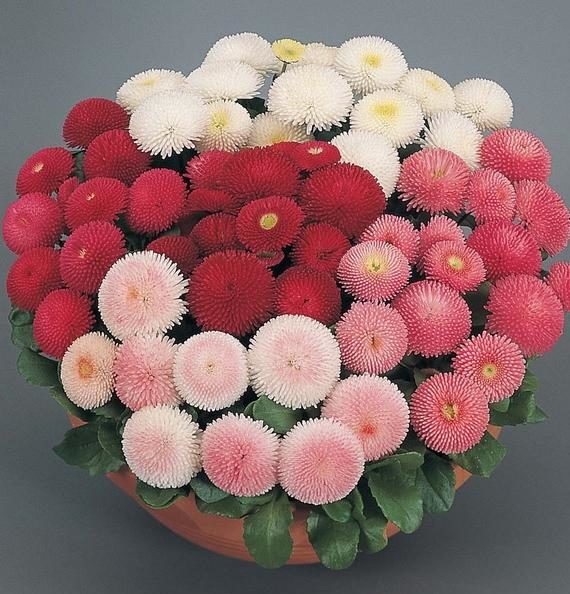
The most common colors are pink, red and white.
From the ancient Greek language, the word "margarites" is translated as "pearl". A similar association is associated with the peculiarity of the appearance of the wild version of the plant. Small snow-white flowers from a distance look like the contents of mollusk shells. In a number of countries, the plant is called the "Eye of the Day". This is due to the fact that the flowers open at the same time as the sun rises.
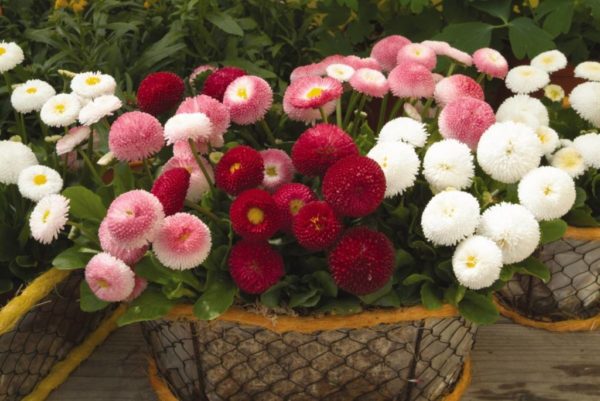
Daisies are in great demand in the creation of garden compositions.
Table 1. Main characteristics
| Part of the plant | Description |
|---|---|
| Height | A small bush that grows up to 30 cm. |
| Socket | Basal, in the form of a blade with serrated edges. |
| Stem | Naked, without foliage. At its base there are leaves blunt at the ends. Only 1 head is formed. |
| Root system | Branchy, small in size. |
| Basket | According to the peculiarities of its structure, plants are classified into tubular and reed. Then they are divided into simple, double and semi-double. The inflorescences contain a large number of serrated petals. The diameter of the baskets is up to 8 cm. They open well in sunny weather. |
| Fetus | Flattened, without a tuft. Ripens from mid-summer to early September. |
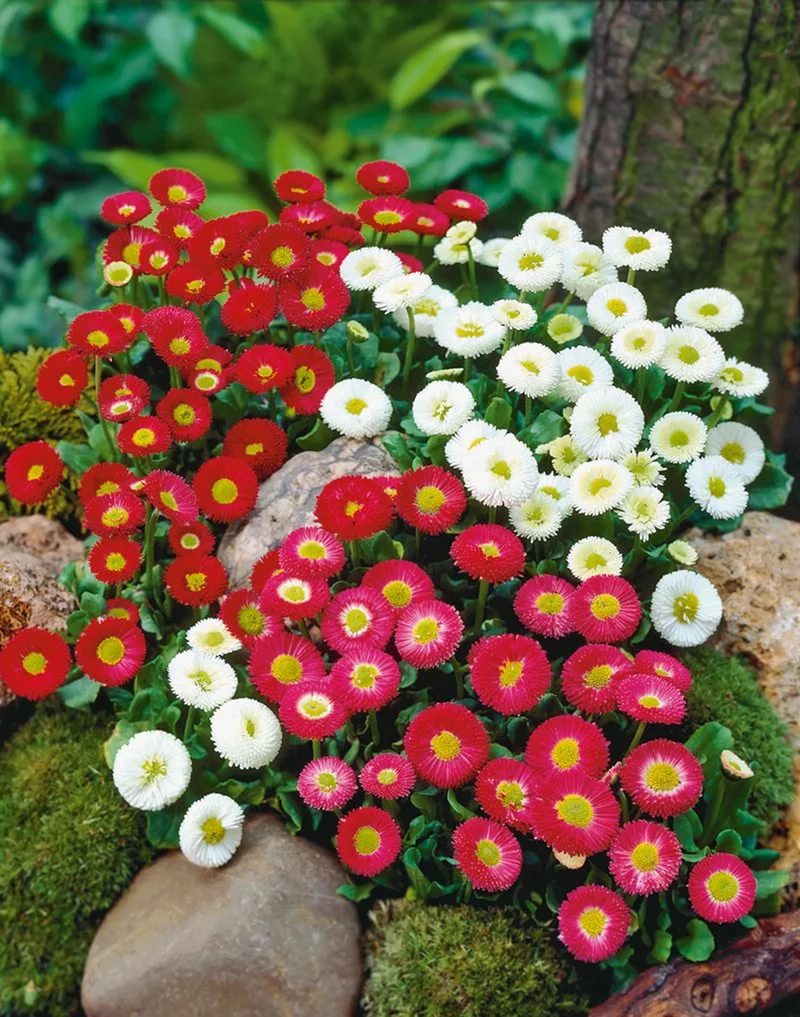
The daisy is the first wildflower to migrate to the garden
Types and varieties of daisies
In culture, two types of daisies are grown - annual and perennial. Planting and caring for perennial daisies is not much different from growing annual daisies, but there are still differences. Annual daisies (Bellis annua) are grown mainly in rockeries or as houseplants to decorate balconies and terraces. Perennial daisies are more in demand in culture, which is why breeding work on the development of new varieties was carried out with perennial plants of this genus.
Perennial daisy (Bellis perennis)
A plant with a height of 10 to 30 cm with oblong-ovate or spatulate leaves, collected in a basal rosette. Numerous pubescent leafless peduncles from 15 to 30 cm in height appear in the second year after sowing. Inflorescences are baskets of red, white or pink color up to 8 cm in diameter with large tubular or ligulate flowers along the periphery and small, golden-yellow tubular flowers in the middle. Perennial daisy seeds are flat, oval, small. This species gives abundant self-seeding, which can be used as seedlings.
According to the structure of inflorescences, perennial daisy varieties are divided into reed and tubular, both groups are represented by varieties with both simple and double, as well as semi-double inflorescences. Simple inflorescences have one to three rows of colored tubular or ligulate flowers and a disc of small yellow tubular flowers in the center. Semi-double flowers have four rows of ligulate colored flowers and a yellow center of small tubular flowers.
Double inflorescences consist of a large number of colored ligulate flowers that almost completely hide the yellow center of tubular flowers. By size, the inflorescences are divided into small (from 2 to 4 cm in diameter), medium (from 4 to 6 cm) and large, reaching more than 6 cm in diameter. The best varieties of perennial daisies:
- Robella - large double inflorescences up to 5 cm in diameter with dense pinkish-salmon inflorescences of rolled tubular flowers. This variety received a gold medal at the Fleroselect competition;
- Rob Roy is a miniature plant with red inflorescences 1-2 cm in diameter;
- Bella Daisy, also a Fleroselect award-winning early blooming daisy with a 2-2.5 cm double basket in bright pink color;
- Pomponette is a daisy with small pompom inflorescences that look like buttons.
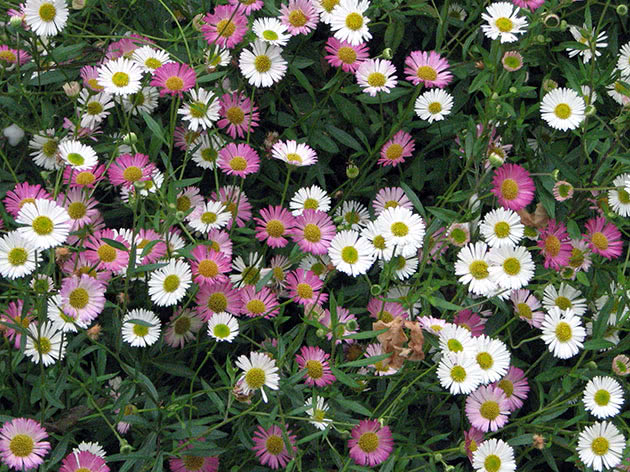
Recently, whole series of daisy varieties have appeared, united by common features, but differing in the color of the inflorescences. Among them, the most attractive for gardeners are:
- Tasso series - daisies on short stems with very dense double pompom-shaped inflorescences of tubular flowers up to 4 cm in diameter in red, pink, white, salmon pink, and also pale pink with a darker middle;
- Speedstar series - a variety that blooms in the year of sowing with semi-double flowers of carmine and white color with a bright yellow center, and in the pink variety, the yellow center is surrounded by a white rim;
- the Rominette series - densely doubled daisies with a diameter of 2 cm in white, red, carmine pink and pale pink. The height of the bush is about 15 cm.
Mallow: a description of growing from seeds
After this article, they usually read
Add a comment
Perennial daisy
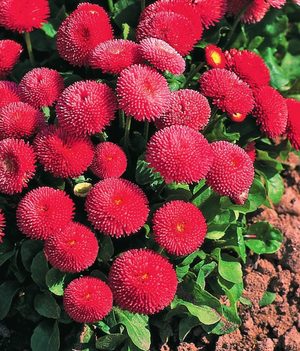
Perennial daisy
A variety of bright colorful colors allow you to use this flower as a decoration for almost any composition.
The flower belongs to the Astrov family. Its name is translated from ancient Greek as - pearl. In ancient times, these were very popular flowers, a number of legends and tales were even added about them. In the east, these flowers are a symbol of youth and innocence.
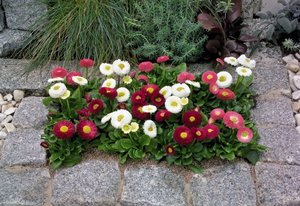
undersized
The rhizome of the plant is short and beveled, the stem, as a rule, without leaves.
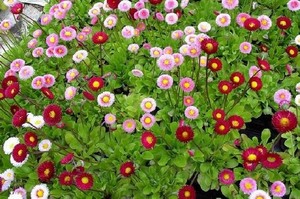
Beautiful flowers are the main decoration of the plant. The inflorescence is formed from a single basket with large flowers along the edge and small flowers in the center. In the central part, usually yellow, golden or white flowers, and pink or red grow along the edges.
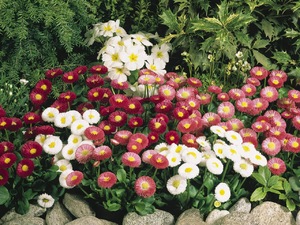
In the wild, daisies are usually short plants that have small, non-double flowers. After prolonged cultivation in summer cottages, cultivation and transformation, breeders have bred a large number of varieties that have a variety of flower sizes and colors.
Perennial Daisy Varieties
The most common varieties are:
- Pompom daisy;
- Daisy Pink;
- Habanera;
- Tasso;
- Robella;
- Speedstar.
Let's consider these varieties in more detail:
- The pompom daisy is a miniature plant that was bred in France many years ago. The main differences of the variety are the presence of many small, up to four centimeters in diameter, double inflorescences that resemble pompons. There can be about forty flowers on one bush. Daisies begin to bloom with the onset of a warm spring - in April and continue until June. Nowadays, thanks to breeders, these plants have received a large number of bright colors. Due to the fact that the flower bushes are small, they are often grown indoors in medium-sized pots.
- Daisy Pink - these are plants with red, bright pink and white color. Usually, the flowers of the bushes of this variety are small, no more than three centimeters in diameter. The most famous representatives of this variety have dark pink flowers and snow-white inflorescences.
- Habanera is a selection series of varieties that are distinguished by large flowers, their diameter can be more than six centimeters. Daisies of this variety have beautiful double inflorescences with elongated petals that have white, pink and red hues. These flowers are frequent guests at various exhibitions and fairs due to their appearance. Daisy baskets are less dense than representatives of other varieties, as a result of which they seem delicate and weightless.
- Tasso is a daisy variety that has thick, short stems and dense and double buds. Representatives of this type of flowers are often two-colored. They have a pale pink color of the petals and a more saturated pink core. Flowers grow no more than ten to twelve centimeters high. Large and dense baskets, consisting of tubular, densely double flowers.Representatives of this variety usually bloom earlier than other types of daisies, as soon as the snow melts and continue to bloom until autumn.
- Robella is a series of flowers that are distinguished by a unique color, it can be coral or salmon. This variety is often used in landscaping, as it can provide a unique atmosphere of comfort and beauty. The height of the bushes of these daisies can reach fifteen centimeters.
- Speedstar is a series with semi-double baskets, which, as a rule, are painted in bright yellow color, which gives the plant a unique and inimitable look. Typically, this type of daisy is used as border and container decorations. They can grow very compactly, which has earned the love of not only gardeners, but also gardeners who equip city flower beds.
Where to plant daisies
We widely use daisies in country borders, in flower beds, we plant them in flower groups on lawns, between trees and shrubs in the garden. Colorful spring carpets are made of them on the ground and planted on balconies. Due to their long peduncles and the ability to stand in water for a long time, daisies are used for bouquets.
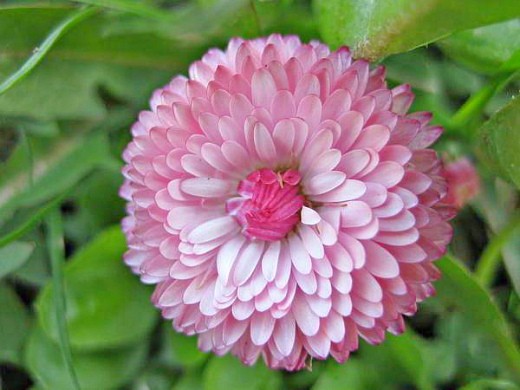
Daisies sown in summer can be admired with success in winter. To do this, we sow seeds in June, and transplant the grown seedlings of plants into pots with a small diameter of 7 centimeters, which we keep in a cool place. In early October (before the onset of frost), the plants are transplanted into pots with a larger diameter and transported to an apartment. In winter, daisies bloom.
Varieties of perennial daisies with photos and names
Perennial daisy varieties allow you to beautifully arrange flower beds with minimal labor costs.
Check out the popular varieties of daisies with photos and names on this page, where the most colorful of them are presented:
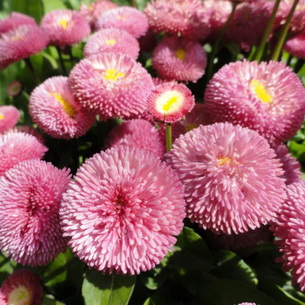

"Rosa gigantea" - daisy varieties with very large pink double flowers, blooms profusely in May and June.
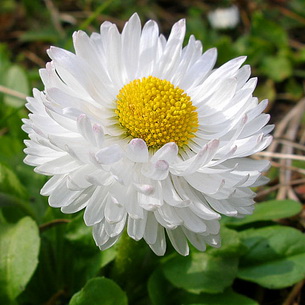
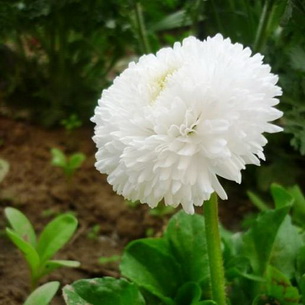
"Schneebel" - with large snow-white flowers, up to 20 inflorescences bloom at the same time. Blooms in May, June.

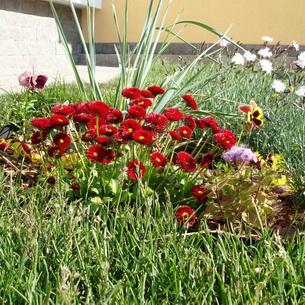
"Etna" - with dark red, ligulate flowers that have grown into a tube and a bright yellow center, up to 25 inflorescences bloom at the same time with a central disc.
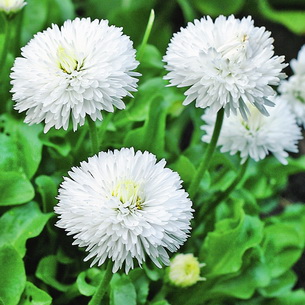
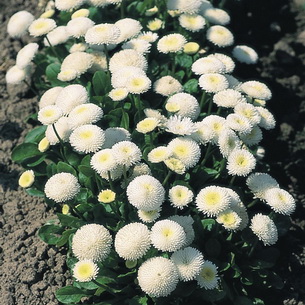
"Snowball" - with a clear white double flowers with an early flowering period. Up to 30 inflorescences bloom at the same time, each inflorescence has a diameter of 4-5 cm.
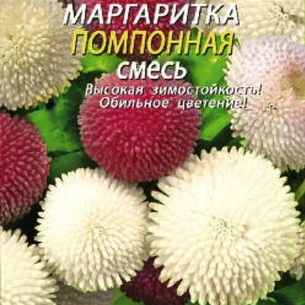
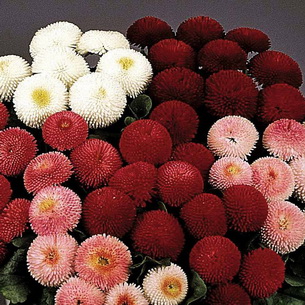
"Pomponnaya Daisy" is a popular variety of miniature daisies. In the bush, up to 40 inflorescences with a diameter of 2.5 cm are possible. This daisy is interesting in that it has an inflorescence with feather-shaped petals. And it blooms from April to July inclusive.
Look at all these varieties of daisies in the photo, which shows plants in the stage of budding and flowering:
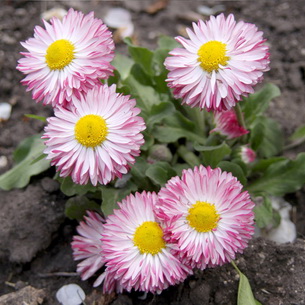
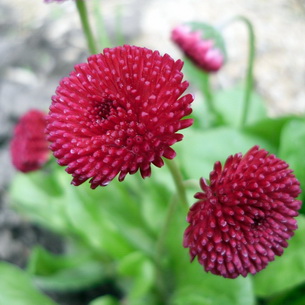

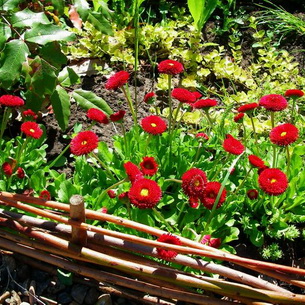
Distribution in nature.
The homeland of the plant is Europe, and the natural range of the daisy does not go beyond its limits. Most often, daisies are found near human habitation, in damp meadows, forest glades, groves, suburban forests and parks, on roadsides.
Outdoor Daisy Care
It is not difficult to take care of daisies, standard agrotechnical measures are carried out. The culture is unpretentious, does not require special care, while it blooms profusely until the very frost.
Watering
The daisy root system is thin and sensitive, it does not tolerate drought, but suffers even more from waterlogging. If the land on the site is constantly damp, then the plant withers, the flowers become smaller. If water stagnates in the place of growth, a swamp forms, then the roots rot, the bush is affected by a fungal infection and dies. Water the daisy when the topsoil dries up.
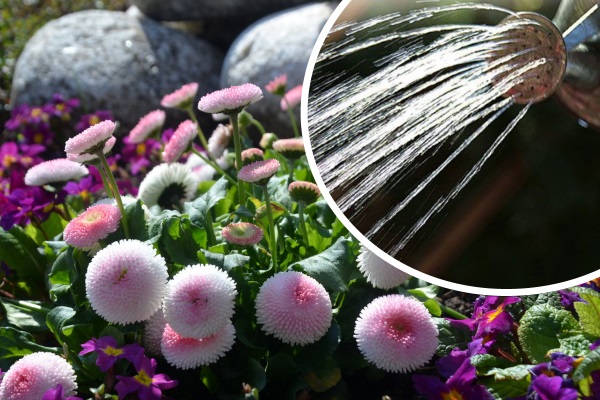
Top dressing
While the daisies are blooming, they need to be fed with complex mineral preparations based on potassium and phosphorus. It is advisable to buy products designed specifically for flower crops.
Loosening and weeding
Caring for a daisy necessarily includes weeding and loosening. Each time after watering, the soil around the bushes is loosened so that the root system does not experience a shortage of air.
It is recommended to cut off dead inflorescences. This measure allows you to make the flowering more abundant. Experienced gardeners advise not to wait until the inflorescence completely withers, but to remove it as it dries.
Mulching
To prevent active evaporation of ground moisture, it is recommended to mulch the soil around young bushes. Sawdust, peat, straw are used as mulch.
As for the grown plants, it is recommended to use sawdust or needles for mulching to prevent the appearance of fungal infection, germination of weeds, and attack of insect pests. The mulch must remain throughout the growing season.
Diseases
The daisy, despite its delicate and fragile appearance, is characterized by a low susceptibility to infectious diseases, but the culture is often affected by viral infections.
In an infected daisy, at the beginning of the growing season, the flower stems are elongated, the inflorescences and leaves become smaller and lose their bright color. Viral diseases cannot be cured. Infected plants are immediately dug up and burned. The soil area on which diseased bushes grew is disinfected with a saturated solution of potassium permanganate.
In rare cases, the daisy gets sick with powdery mildew. The disease is accompanied by the formation of a soft pale gray plaque on the petals and leaf plates. Infected plants are destroyed, if a small part of the bush is infected, then it is cut off and thrown away. Daisies, on which there are no symptoms of the disease, for prevention are sprayed with Topaz, Bordeaux solution or colloidal sulfur.
Pests
Sometimes daisies suffer from a tick attack. Insect control is carried out using strong insecticides "Karbofos" and "Actellik".
Mice can harm the plant. To get rid of rodents, poisoned baits are laid in different places of the garden plot.
Seed collection
Due to the fact that the seeds of a perennial daisy do not ripen simultaneously, but gradually, they need to be harvested a little 1-2 times a week.
To obtain seed, cut the required number of dried inflorescences
It is important to do this before the next watering and the establishment of rainy weather, otherwise the collected inflorescences will be empty: water will wash away all achenes from them
Seeds are shaken out of the cut baskets, laid out in a thin layer on clean paper, and left to dry in a ventilated room. Dried achenes are poured into paper envelopes. Seed material is stored in a shaded and dry place.
Preparation for wintering
The root system of daisies may suffer if the winter is expected to be frosty and with little snow. To protect the delicate roots, the ground around the bushes must be covered with a thick layer of mulch for the winter. You can use peat, sawdust, humus. The thickness of the protective cover must be at least 8 cm.
It happens that the soil subsides, the bushes rise above it, due to which the upper part of the roots is exposed. In this case, thorough mulching during the winter is required. In spring, plants with bare roots need to be transplanted to another location at the optimum depth.
Watch a video on how to plant daisy seeds for seedlings, plant a plant in open ground and properly care for it:
Even an inexperienced gardener can handle planting perennial daisies and further care for these unpretentious flowers. Observing simple agrotechnical requirements, everyone can make a beautiful flower carpet out of an ordinary garden lawn.
Daisy growing options
Daisy is a biennial. When grown by cuttings or seed, abundant flowering is noted only the next year.In order for the plant to bloom in the year of planting, use the method of dividing a bush or growing seedlings.
From seed (seedling)
Perennial daisies lend themselves well to growing by the seed method. For seedlings, you can use both purchased and self-collected seeds.
Features of the collection and use of seed:
- the seeds are harvested little by little over several weeks;
- collection is carried out in clear weather before the onset of the autumn rains;
- daisy seeds are small (1 g contains more than 1.5 thousand pieces), so there is more than enough seed material;
- seeds retain the ability to germinate for 3 years.
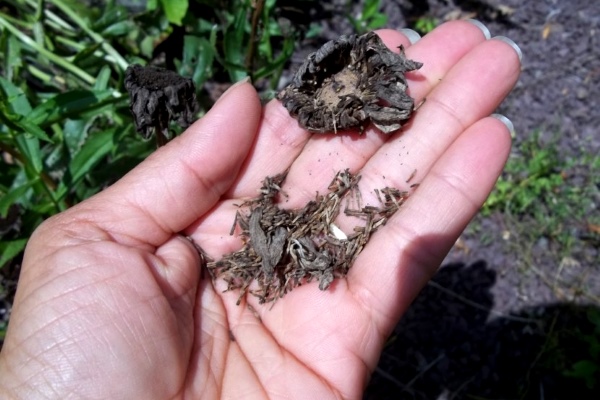
Achenes prepared for sowing will not hurt to be treated with a growth stimulant, but this procedure is optional. The stimulating drug contains substances that make plants grow more actively and more amicably, become less susceptible to infection and parasites.
If you want the daisies to bloom early, then you should sow the seeds for seedlings at the end of February or March. It is better to use small planting containers for separate placement of seeds: cardboard or peat pots, plastic cups. Then the seedlings will not have to dive. If a wide common container is used, then picking young plants is required.
The main principles of planting seeds and growing seedlings:
- Seeds are sown into a container at a sufficient distance from each other, sprinkled on top with a thin layer of soil. At the bottom of the container, drainage holes are necessarily made so that the seedlings do not get sick due to waterlogging of the soil.
- The container is covered with plastic wrap to maintain the greenhouse effect. The film is lifted daily for ventilation.
- After seed germination, the film coating is removed.
- Seedling maintenance involves moderate watering and adequate lighting. The seedlings do well and do not get sick if the soil is constantly moist. The light period lasts 14 hours, therefore additional illumination is provided at the location of the container with seedlings.
- Diving is carried out after the appearance of two true leaves on the seedlings' stems.
- In the second half of May, about a week before transplanting seedlings into open ground, hardening is carried out. Young plants are periodically taken out of the room to the street. In the first days, leave for a couple of hours, then for half a day, then for the whole day.
From cuttings
Reproduction by cuttings is carried out in the second half of May. Shoots containing an axillary bud are carefully cut from the mother plant with a knife.
The cuttings are treated with the Kornevin preparation, planted in the ground in an unheated greenhouse, and deepened by 1 cm. The rooting process takes about 2 weeks. But you cannot immediately transplant young plants to a permanent place - this is done in early autumn, when the days become cool.
Another option is to place the cuttings on the windowsill in separate containers, grow in room conditions until autumn, and make sure that the soil remains moist. It is advisable to use a store-bought light and nutritious substrate for flower crops. Rooted cuttings are transplanted to a permanent place in September, and are sheltered for the winter.
By dividing the bush
Reproduction by this method is carried out in early spring or after flowering. For the procedure, strong, disease-free biennial plants are selected, carefully dug out
It is important not to injure the roots, so there is no need to shake them off the ground
Each bush is divided into about 5 parts. Roots should extend from each part. The buds and inflorescences are cut off, the roots are cut to 10 cm. New plants are planted in the ground.
Growing daisy flowers in the open field: reproduction and care
When grown outdoors, the daisy loves open, sunny places, but it can grow with partial shade, especially during the hot midday season.You can cultivate daisy flowers in any garden soil, but it grows better and blooms more profusely on fertile lungs of well-drained loams.
Daisy propagation by seeds, dividing the bush and cuttings is allowed. Seeds are sown in late June - early July to a depth of 0.5 cm. Seedlings appear in 7-10 days, after picking they are planted in August in a permanent place. Seedlings from self-seeding can also be dived and planted in flower beds. However, if only self-seeding is used for reproduction, then varietal qualities disappear over the years - the inflorescences become smaller and become simple from terry ones.
By dividing the bush, they are usually propagated in August - early September, as well as in April. The bushes are divided into 4-6 parts, while in the most decorative and healthy specimens, almost all leaves are cut off, leaving petioles, and shorten up to 5-8 cm roots (this contributes to the rejuvenation and better survival of plants). Already formed buds and flowers are pinched. Growing a daisy and caring for it in the open field with this method of planting will not be difficult.
If the old bushes are not divided or transplanted, in the 3rd year the flowers become stunted and die. Spring and the flowering period is the best time to dig up daisies and divide mature bushes, with proper care, a whole flower bed of daisies can be grown from one bush. When planning to care for a daisy during cultivation, remember that these flowers love moisture, in the hot season it is advisable to water them often, but at a moderate temperature, it is enough to water the plant 2-3 times a week. However, the ground around the plant should not be too wet, otherwise the roots may rot.

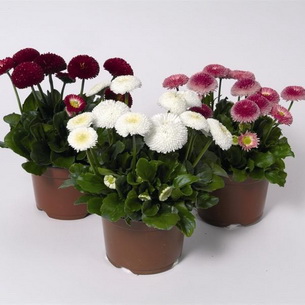
Daisies bloom more magnificently if at the beginning of the season they are fed with a solution of complete mineral fertilizer. Usually, a nutrient solution is prepared for this, with which the plants are watered. But on loamy soils, you can make top dressing even before the snow melts by scattering dry fertilizer over its surface. This will help save time on caring for the plant in the summer.
Daisies planted on heavy soil often suffer from bulging in the spring. That is, they rise on the roots above the ground, therefore, before sowing or planting in the soil, it is necessary to add 4-5 kg of humus and good compost, as well as coarse sand. Bulging of bushes can also occur at dramatically changing temperatures - up to minus nights and positive days, it is especially dangerous in the absence of snow cover. In order to avoid this phenomenon, planting should be mulched in the fall with peat, humus, sawdust and other materials with a layer of 8 cm.If in the spring they noticed that bulging has occurred, the plants should be transplanted to a new place at the usual depth.
Large-flowered daisies also need shelter for the winter and are also mulched in late autumn.
Top dressing. In May, at the beginning of flowering, the plants are fed: for 10 liters of water, they are diluted in 2 a tablespoon of nitrophosphate and Agricola Fantasy, 1 liter of solution is poured under each bush.
Diseases and pests. Daisies are weakly affected by diseases, but sometimes there is gray rot on the leaves, buds and inflorescences, as well as powdery mildew and rust. In addition to fungal diseases, daisies are damaged by scoop caterpillars and slugs.
Control measures. After flowering, the plants are treated against diseases: 40 g of "Homa" are diluted in 10 liters of water. When powdery mildew appears, it is treated with Topaz (1 ampoule / 4 ml / for 8 l of water). When slugs appear, the drug metaldehyde is laid out (30 g per 10 sq. M).
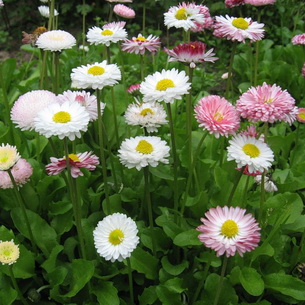
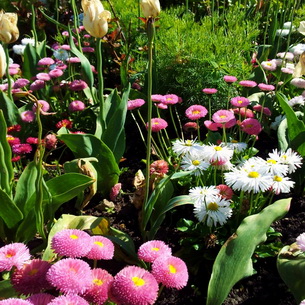
The daisy is decorative during mass flowering, which occurs in the spring and gradually fades towards the end of summer. Inflorescences appear in the second year. In the sunlight, the baskets open wide, at night or in rainy weather they close and droop. After flowering, the leaves of the rosettes turn brown and dry out.

